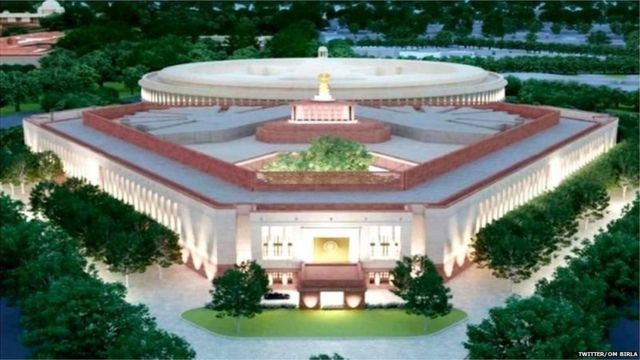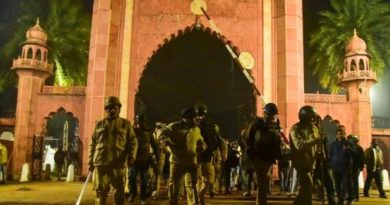Why is the Modi government anxious about the new building of Parliament House? Allegations of neglect of rules
As more information is being received on the proposed Central Vista project of the Government of India, the list of questions related to it is also getting longer.
The trial against this project which gives a new appearance to Central Delhi is going on in the Supreme Court. The issue of debate is the same – plans for the construction of many buildings between Rashtrapati Bhavan and India Gate including a new Parliament House, right or wrong?
The current Central Vista is a historical area that people come from far and wide to see and the beauty as well as the corridors of power have been here.
Bahral, Central Vista will give a new strength to Parliament and the new building will cost about 971 crores
However, the demand for increasing the place in Parliament has been arising for more than 50 years and it was also debated during the tenure of Lok Sabha Speaker Meira Kumar in the previous UPA government.
However, little was heard about the current project, so when the BJP government announced it only months after the 2019 election victory, some were also surprised.
Actually, the central vista is called the area on both sides of Rajpath which includes the area of Princes Park near Rashtrapati Bhavan near India Gate.
Rashtrapati Bhavan, Parliament, North Block, South Block, the home of the Vice President are also covered under Central Vista.
The existing Central Vista also includes the National Museum, the grand building of the National Archives, the Indira Gandhi National Center for the Arts (IGNCA), Udyog Bhawan, Bikaner House, Hyderabad House, Nirman Bhawan and Jawahar Bhawan and all these buildings are redesigned and strengthened. The total cost of the project is being reported as Rs 14,000 crore.
A year after the announcement, Prime Minister Narendra Modi laid the foundation stone of a new building in which more than 1200 MPs and their staff will be able to sit together.
The Prime Minister said, “Beautiful, what will be more sacred than this, that when India celebrates 75 years of its independence, the inspiration of that festival should be the new building of our Parliament … It will change itself according to the time and needs. Effort”.
Raising questions
The date of completion of the proposed Parliament House is 2024 but with a big question whether the Supreme Court will allow it to be built? While the government has assured the Supreme Court to include everyone’s opinion and methods, the Supreme Court has described the government’s stand on the creation of Parliament as ‘aggressive’.
Narayan Murthy, a petitioner and senior architect who goes against Central Vista in the Supreme Court, believes, “The way this project is going, it is neglecting all our processes and institutions.”
He told, “For me and you, there is an FIR that tells how much we can build on a plot. It is not allowed if we build even more than ten square meters and the team of MCD comes and breaks it. But, if the government is making one and a half times the height allowed, one and a half times as much as is allowed in the FAR, then what is this learning for the country. Does this mean that the one whose sticks, his buffalo?
Opinions are divided on the need, cost, government permissions or the design of the proposed Parliament building. The question is bound to arise whether this has happened before in independent India.
Modern historian and former professor of Jawaharlal Nehru University, Mridula Mukherjee believes, “Most projects in modern India are built through competition, whether national or international.”
According to him, “IGNCA, be it or anyone else, people, artists or architects, were all involved in the process of their formation. Right now I think whoever is the government or the bureaucracy, is very much dominating it. Now Just like there is a Parliament building, the opinion of those who have spent time in Parliament or are still there is not seen anywhere. At present, it seems that the government does what it thinks is good for the people, tells them without discussion Made “.
What does the government say?
At the same time, the central government claims that the project is in the ‘national interest’ because the need for modernizing the Central Vista will save hundreds of crores of rupees and the new buildings will become more robust and earthquake resistant.
The question has been to build more buildings in this green and open area, the government says that it is going to bring more greenery in it. But more voices of protest have been raised about the environment.
Kanchi Kohli, an environmental expert at Delhi’s Center for Policy Research, opined, “The proposed buildings have been separated from the entire project by resorting to the law, while it is clear in the government’s own press release from the beginning that it is part of the entire project.” . “
He said, “The whole environment approval process was done in a manner like plot by plot, building by building. First of all you broke the whole project to get environmental acceptance and said that because this is just an exception project So there is no need for environmental assessment “.
Currently, the ball is in the court of the Supreme Court, which allowed the government to lay the foundation stone of the new Parliament, but has banned any sabotage or new work.
Foundation of existing central vista
By the way, history is witness that Delhi was the capital of many emperors and rulers, in which construction work was done continuously. This trend continued before and after independence, in which the shape of the city changed and the famous Buildings were built.
The foundation of the current Central Vista was laid when King George-5 of Britain announced in 1911 that Delhi would be shifted from Calcutta, the country’s capital.
The Town Planning Committee consisted of the British architects Edward Lattens and Herbert Baker who overturned the committee’s initial decision in which the capital was to be built in Shahjahanabad area of Delhi. A hill named Raisina Hill was chosen for a grand capital.
There were differences before, but not between the government and ordinary citizens.
Friends Latens and Baker, who designed Central Vista, had differing opinions on the height of the Rashtrapati Bhavan, North and South blocks, and according to historians, it soured their deep friendship.
This is not evident in the current government, but many citizens groups and common citizens have reached the court on the claim of government transparency.
But in response to what can be likened to the British-ruled and now Central Vista, Mridula Mukherjee, a modern historian and former professor at Jawaharlal Nehru University, says, “His consultation process was within his government and of course he took the Indian nationalists. Did not consult with the citizens, not at all with ordinary citizens because at that time there was no question. “
He said, “Indians did not participate in the government in the first two decades of the 20th century and only grew after 1930. But now there are no such situations, I think it was a good opportunity and there were changes to be made, then the process was second The second thing was to happen. I did not understand that if experts, architects, citizens or some political groups have objected to this process then what is wrong with it, why can’t it be heard? “
Controversy did not happen in National War Memorial
When this area was built, the rule of the British government, which took the decision, came to an end in 1947. The decision to reconstruct these buildings, known as the identity of India, is now being taken by the democratic government of the country.
Narayan Murthy, a petitioner and senior architect who goes against the Central Vista in the Supreme Court, feels, “In the initial master-plan, the planners thought that this place between this city and this nation should be public only.”
He further added, “In the master-plan of the Latens, that was what is going to be built today – there were ten big buildings for the office. While the master-planners of our country stopped it and the four-five buildings which President Bhavana or Turns to Vijay Chowk, where Shastri Bhavan or the building Bhavana is today, except for them, in the roundabout around India Gate, all that land was in the name of the public. “
However, if it is for the last few years, then the National War Memorial of Delhi is an example to the contrary.
The demand for making it has been there since 1960 but the decision of construction came when BJP came to power under the leadership of Narendra Modi in 2014. Global design tenders were available for a year in which architects from India and abroad joined their model.
There was a slight delay in its preparation, but the controversy was neither equal to that of the existing Central Vista project.
According to environmental expert Kanchi Kohli, “The area of Central Vista is not just the heritage of the whole country. So when we are deciding about the country’s heritage, why not make a mass amendment? Why not involve the public First, tell us what is the plan, take public input on it, only then creative ideas will come out and people will feel that we have created this place by thinking together. “




